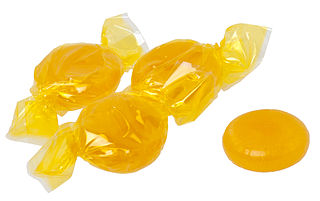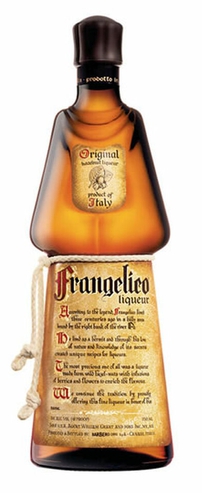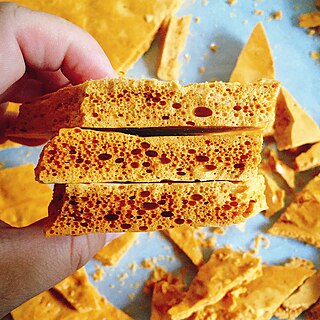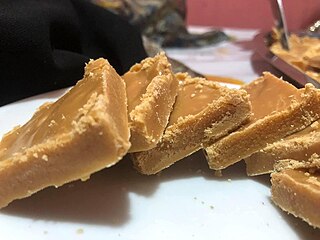History
The use of treacle (or molasses) in the United Kingdom began in the 1660s, when it was first used to make gingerbread. [5] [6] Bonfire toffee emerged soon thereafter. [5] However, treacle was considered medicinal at the time, and was therefore very expensive, [6] limiting the spread of toffee as a dessert or snack food. The term "toffee" did not appear in print until 1825 [7] although foods were often cooked several decades before their names or recipes for them appeared in print. [6] Toffee developed in northern England some decades earlier (perhaps by the mid-18th century), and had displaced formerly popular sweets such as candied fruit, fruit preserves, marmalade, and similar items. [5] [8] Toffee was widely popular by 1800. [8] At this time, toffee took many forms, including a soft version much like taffy, and was often called "toughy" or "tuffy". [8] It was also known as "treacle sweetmeat", the suffix "-meat" having the meaning of any food. [9] However, it is not entirely clear as to why it became associated with Guy Fawkes Night. [1]
From about 1830 to 1900, bonfire toffee was quite popular in Yorkshire. [10] In the 1890s, it was sometimes called "Tom Trot". [11] Bonfire toffee was usually a homemade confectionery. Although industrial manufacturing of confectionery had begun in the 1840s, the price of black treacle in the 1890s and first decade of the 20th century often rose above the price of sugar which made store-bought toffee too expensive for many. [12] Even in the 1960s, it was common for older people in a neighbourhood to make bonfire toffee to hand out to children on Guy Fawkes Night. [13]
By the mid-1950s, bonfire toffee was often made in large sheets and pieces broken off with a toffee hammer. [14] [15] This practice was discouraged by some due to concerns about food safety. [14] Treacle toffee was once common in sweet shops, but in the late 20th century was usually only available in supermarkets in October and November. [16] However, it is still available year-round in speciality sweet shops, where it is usually broken by hand and wrapped in paper. [1] It may be purchased as a sort of lollipop, on a stick with the foil dish it was made in still attached, or in sheets for breaking up and consuming at home.
Bonfire toffee is primarily consumed in the northern part of the United Kingdom, where sweets darker in colour are preferred. [17]
Although bonfire toffee is usually considered a Halloween or Guy Fawkes Night treat, it has a Christmas association as well. In Wales, an old tradition exists of plygain, a Christian worship service held between 3:00– 6:00 a.m. in which Christmas carols are sung (and sometimes, but not always, accompanied by holy communion). [18] After plygain was over, people would stay awake to decorate the house, play cards, eat cake or pikelets (a variation of the crumpet), or make bonfire toffee. [19]
Ingredients
The ingredients often include butter or margarine, black treacle, sugar, and sometimes white vinegar. The treacle is the critical ingredient, for it is less sweet than sugar and has a slightly bitter flavour that gives bonfire toffee its unique taste. [20] One recipe calls for 230 grams (0.5 lb) of butter, 230 grams (0.5 lb) of treacle, and 450 grams (1.0 lb) of brown sugar. [21] The mixture is cooked over medium heat until melted, and allowed to boil (being constantly, rapidly stirred) for 15 minutes. [21] The hot mixture is then poured into buttered forms (such as a cake pan or special forms). [21] Recipes calling for the use of vinegar vary these ingredients. For example, one recipe from 1922 calls for 550 grams (1.21 lb) of dark brown sugar, 280 millilitres (10 imp fl oz; 9 US fl oz) of treacle, one tablespoon (15 millilitres; 0.53 imp fl oz) of vinegar, one tablespoon (15 millilitres; 0.53 imp fl oz) of butter, and one teaspoon (5 millilitres; 0.18 imp fl oz) of sodium bicarbonate (or baking soda). [22] White vinegar gives the toffee a slightly sharper taste, and alters the chemistry of the toffee so that it is not so brittle. [1] It also helps the toffee to set. [23] Other recipes call for about 2.8 litres (5 imp pt) of water, and vary the amount of the other ingredients. [22] Some recipes call for the use of golden syrup instead of treacle. [24]
It can be cut or rolled into sticks while still warm. [22] [25] Some recipes call for essence of almond, lemon, or peppermint to be added for flavour, or for cayenne pepper to be added to give it a spicy kick. [22] [25]
Generally speaking, little fat is used in the mixture, [16] and the moisture content of the food is low. [26] Food colouring (usually dark brown or black colour) is used in cheaper versions, when not enough treacle is present in the mixture to turn the toffee a dark colour.
By one estimate, 100 grams (3.5 oz) of bonfire toffee has 500 kilojoules (119 kcal), 4.3 grams (0.15 oz) of protein, 21.2 grams (0.75 oz) of carbohydrates, 1.9 grams (0.067 oz) of fat, and 0 grams (0 oz) of dietary fibre. [27]

Confectionery is the art of making confections, or sweet foods. Confections are items that are rich in sugar and carbohydrates although exact definitions are difficult. In general, however, confections are divided into two broad and somewhat overlapping categories: bakers' confections and sugar confections.

In recipes, quantities of ingredients may be specified by mass, by volume, or by count.

Halva is a type of confectionery that is widely spread throughout the Middle East and North Africa, the Balkans, and South Asia. The name is used for a broad variety of recipes, generally a thick paste made from flour, butter, liquid oil, saffron, rosewater, milk, turmeric powder, and sweetened with sugar.

In cooking, syrup is a condiment that is a thick, viscous liquid consisting primarily of a solution of sugar in water, containing a large amount of dissolved sugars but showing little tendency to deposit crystals. In its concentrated form, its consistency is similar to that of molasses. The viscosity arises from the multiple hydrogen bonds between the dissolved sugar, which has many hydroxyl (OH) groups.

Fudge is a type of dessert bar that is made by mixing sugar, butter and milk. It has its origins in the 17th century United States, and became popular in American women's colleges in the late 19th century. Fudge can come in a variety of flavorings depending on the region or country it was made; popular flavors include fruit, nut, chocolate and caramel. Fudge is often bought as a gift from a gift shop in tourist areas and attractions.

Toffee is an English confection made by caramelizing sugar or molasses along with butter, and occasionally flour. The mixture is heated until its temperature reaches the hard crack stage of 149 to 154 °C. While being prepared, toffee is sometimes mixed with nuts or raisins.

Butterscotch is a type of confection whose primary ingredients are brown sugar and butter. Some recipes include corn syrup, cream, vanilla, and salt. The earliest known recipes, in mid-19th century Yorkshire, used treacle (molasses) in place of, or in addition to, sugar.

Frangelico is a brand of hazelnut and herb–flavored liqueur coloured with caramel coloring, which is produced in Canale, Italy. It is 20% alcohol by volume (ABV) or 40 proof. Formerly, it was 24% ABV or 48 proof. When produced by the Barbaro family it was bottled at 28% ABV or 56 proof. The brand was created in 1978. It is known for its unusual packaging; its bottle was designed to look like a Christian friar, complete with a knotted white cord around the waist. It is commonly sold in two sizes: 750 ml and 375 ml.

Chess pie is a dessert with a filling composed mainly of flour, butter, sugar, eggs, and sometimes milk, characteristic of Southern United States cuisine.

Honeycomb toffee, honeycomb candy, sponge toffee, cinder toffee, seafoam, or hokey pokey is a sugary toffee with a light, rigid, sponge-like texture. Its main ingredients are typically brown sugar and baking soda, sometimes with an acid such as vinegar. The baking soda and acid react to form carbon dioxide which is trapped in the highly viscous mixture. When acid is not used, thermal decomposition of the baking soda releases carbon dioxide. The sponge-like structure is formed while the sugar is liquid, then the toffee sets hard. The candy goes by a variety of names and regional variants.

Nonpareils are a decorative confections of tiny balls made with sugar and starch, traditionally an opaque white but now available in many colors. They are also known as hundreds and thousands in Australia, New Zealand, South Africa, and the United Kingdom. In the United States, the same confectionery topping would generally be referred to among the general public as "sprinkles," regardless of their composition.

Parkin is a gingerbread cake traditionally made with oatmeal and black treacle, which originated in Northern England. Often associated with Yorkshire, it is widespread and popular elsewhere, notably in Lancashire. Parkin is baked to a hard cake but with resting becomes moist and even sometimes sticky. There are regional differences; for example, in Hull and East Yorkshire, it has a drier, more biscuit-like texture than in other areas, whereas in Lancashire it is generally made with golden syrup rather than with the treacle used elsewhere. Parkin is traditionally eaten on Guy Fawkes Night, 5 November, and when celebrating "Yorkshire Day" on 1 August, and it is also enjoyed throughout the winter months. It is baked commercially throughout Yorkshire but is mainly a domestic product in other areas.

Treacle tart is a traditional British dessert. The earliest known recipe for the dessert is from English author Mary Jewry in her cookbooks from the late 19th century.

Barley sugar is a traditional variety of boiled sweet, often yellow or orange in colour, which is usually made with an extract of barley, giving it a characteristic taste and colour. In Britain it is usually sold in the shape of twisted sticks. Barley sugar is very similar to clear toy candy and to hard caramel candy in its texture and taste.

Summer pudding or summer fruit pudding is an English dessert made of sliced white bread, layered in a deep bowl with fruit and fruit juice. It is left to soak overnight and turned out onto a plate. The dessert was most popular from the late 19th to the early 20th century. It first appears in print with its current name in 1904, but identical recipes for 'hydropathic pudding' and 'Malvern pudding' from as far back as 1868 have been found.

Creamed coconut, also known as coconut butter, is a coconut product made from the unsweetened dehydrated fresh pulp of a mature coconut, ground to a semi-solid white creamy paste. It is sold in the form of a hard white block which can be stored at room temperature. The block is generally packaged in a sealed plastic pouch and some separation of the fat and the coconut flesh can be seen. It may also come in bottles similar to how most nut butters are packaged. In cookery, it is chopped into pieces or grated before it is added to dishes. By adding warm water it can be made into coconut milk or coconut cream substitutes. Adding water to creamed coconut in the ratio 5:2 gives a coconut cream substitute, 5:1 gives a coconut milk substitute.

Macun is a soft, sweet and colorful Turkish toffee paste. It is a street food that may be prepared with many herbs and spices. Macun originated from spicy preparations of Mesir macunu, a traditional Turkish herbal paste from the classical antiquity period. During classical antiquity, macun was consumed as a pharmaceutical medicine. It was historically served in a round tray with separate compartments for the various flavors, a serving style that has continued into modern times. The consumption of macun is a part of some Turkish customs.

The Queen-like Closet, Or, Rich Cabinet was a cookery book published in 1670 by the English writer on household management, Hannah Woolley. It ran through five English editions by 1684. At least two German editions were also printed.

Kiri Aluwa, also known as milk toffee or kiri toffee, is a popular traditional Sri Lankan soft toffee.



















